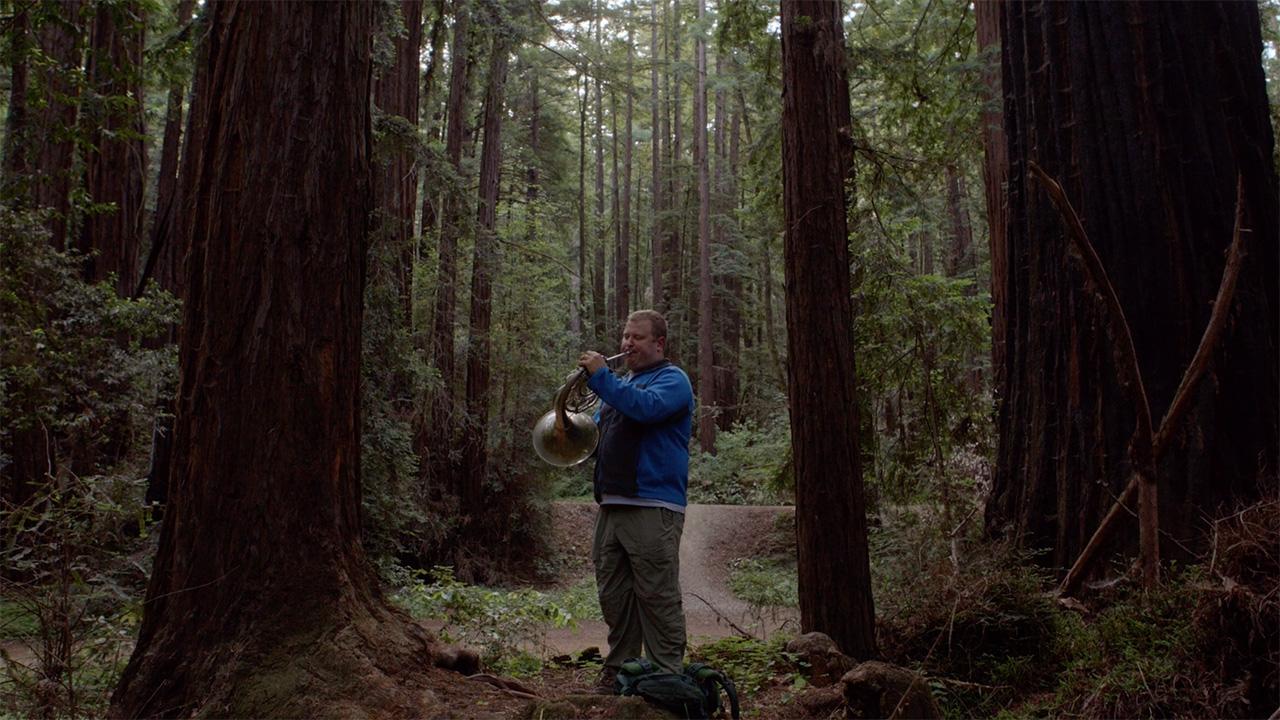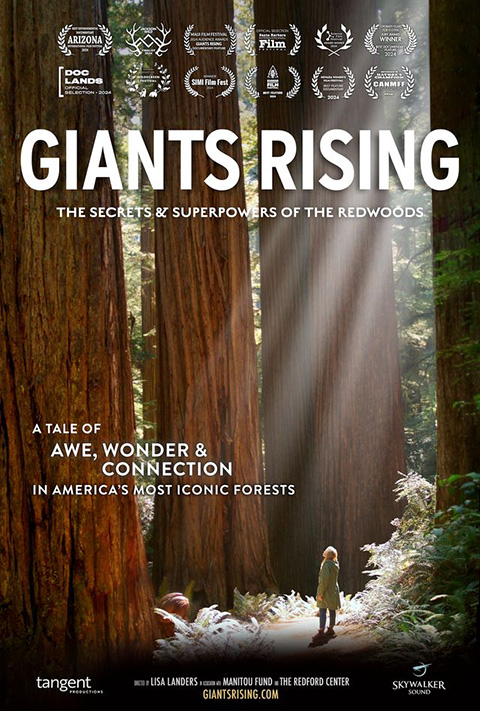
New film: Redwoods inspire Moore to explore their secrets
“Giants Rising” features UC Davis grad
In a fog-tinged forest, graduate student Zane Moore stands before the up-swirling-bark base of a coast redwood. He plays a flowing tune on his horn, then pauses. He holds the horn to his heart and gazes upward, biting his lips.
It’s a spiritual moment, captured in a new film documentary. The award-winning “Giants Rising” starts streaming Saturday, Nov. 1, on PBS.org, followed by broadcasts on PBS television channels nationwide throughout November; check your local listings here. Moore earned a Ph.D. in plant biology from the UC Davis Department of Plant Sciences after working to unravel secrets of the world’s tallest tree, which is native to coastal California.
“If we want to learn more about what makes a redwood tree so remarkable – its height, its size, its age and how they’re so resilient, genetics would be the way to answer some of these questions,” Moore says in the film. “We’re learning a ton about these trees.”
That moment was filmed in 2022, and Moore graduated not long after. Judy Jernstedt, a professor emerita in the department, was his major advisor. In the course of his studies, Moore also worked with David Neale, a distinguished professor emeritus in the department known for his work to sequence the genome of both the coast redwood and its inland cousin, the giant sequoia.
The documentary fits squarely into Moore’s passions, Jernstedt said on the eve of the documentary’s PBS release. “He’s always been big on science education and science for the public,” Jernstedt said. “He believes he can do the most good for the most people in outreach and education.”
Since graduating, Moore has worked as a science teacher in regional schools and contributed to other works on redwoods, including “The Coast Redwood, Sequoia sempervirens: A primer.” The document, by Michael Roa, is designed to help teachers and was published earlier this fall.
“Giants Rising” was written, directed and produced by Lisa Landers of award-winning Tangent Productions, based in Marin County, Calif. The documentary already has received critical acclaim on the festival circuit, including a win at the SIMI Film Festival in Simi Valley, Calif., in 2024.
A model for adapting to climate change?
As part of the documentary, Landers filmed Moore in Jernstedt’s lab at UC Davis to show “the process associated with extracting the DNA from a redwood seed – part of the process of sequencing the redwood genome,” Landers wrote. By studying redwood genetics, we can gain valuable insights into problems people face today, Moore added.

"My work looked at redwood mutation rates," Moore explained. "We found that redwoods change quickly over time, because a single redwood has genetically distinct branches in its crown.
"Redwoods also have six sets of chromosomes," Moore continued. "That means more genetic mutations can occur that are potentially beneficial.
"To me, this means redwoods have a superior ability to adapt in the face of climate change," Moore added. "Many organisms with long life spans probably are susceptible to climate impacts, but redwoods show these surprising characteristics of a fast mutation rate and multiple copies of each gene.
"This will help them adapt in the future," Moore said.
Trees and people: “All one thing”
In another segment of the film, Moore explains what redwood-forest lovers call “fairy circles.” Daughter trees – clones – sprout from the base of a dead mother tree, growing in a towering circle. Underground, their root network supports and nourishes them. They are “physically and genetically connected,” Moore explains. “All one thing.”
The documentary keeps returning to the theme of connection – especially, between the trees and people. A photographer muses about how the majestic conifers shape her creativity. A mother describes the primordial connection felt for the trees by her people, the indigenous Yurok. A neuroscientist explains early research to understand how the awe people feel when in the trees’ presence – like what Moore displays after his horn serenade – changes the brain and reduces stress.
In contrast to the awe, inspiration and connection the trees offer us, Landers highlights the threats posed by climate change, fire and human-caused destruction. She notes the trees’ challenges “mirror our own.”
“Redwood trees can live for more than 2,000 years, but they are not invincible,” Landers wrote. In the course of “Giants Rising,” she seeks to show how scientists such as Moore, along with tribal leaders, park managers and others, are “working together to protect and restore these carbon capturing allies.”
Moore hopes the documentary would encourage people and government officials to step up funding for both research and public institutions. "It's valuable for people to focus on studying redwoods," he wrote. "They're an example of why we need to encourage public and private funds to go towards research of biodiversity broadly-speaking."
Media Resources
- Trina Kleist, UC Davis Department of Plant Sciences, tkleist@ucdavis.edu or (530) 601-6846.
- Read about the project to sequence the genomes of the coast redwood and giant sequoia here.
- Watch the film, "Giants Rising," here
